
Throughout its history, there are many examples of the automotive industry leveraging technology transfers from adjacent and complementary markets - industrial, consumer, and healthcare to name a few.
Ranging from the revolution of automobile mass production through the introduction of conveyor systems from the mining industry to the harnessing of processing power, which has continued apace since electronic control units (ECUs) first leveraged microcontroller capabilities over 30 years ago, the examples of the automotive industry borrowing and benefiting from technology transfers are too numerous to list. Now, the automotive industry is returning the favour by sharing a technology that promises to simplify audio distribution challenges in a diverse array of applications.
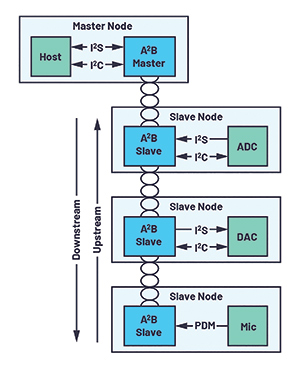
How A2B works
The A2B bus is a high-bandwidth, bidirectional, digital bus originally conceived to solve audio distribution challenges in automotive applications. Existing automotive audio networks typically involved multiple point-to-point analog connections.
A2B technology addresses many of the challenges that characterised point-to-point analog connections: cable weight, cable cost, routing difficulties, and the reliability of multiple connections. It facilitates the transport of fully synchronised audio data (I2S/TDM/PDM) and control data (I2C) throughout a distributed multinode audio system over an unshielded twisted pair (UTP) cable and connector infrastructure. Up to 32 channels of audio are supported on the bus in both upstream and downstream directions, giving a total bandwidth of 50 Mbps. A2B technology can support point-to-point, daisy-chain, and branch network topologies.
Every network is comprised of a master node and up to 10 slave nodes. A master node contains an A2B transceiver connected to a host processor that can send audio, control data, and I2C data onto the A2B bus. Slave nodes, which vary in complexity from premium amplifiers with significant processing power to bus-powered microphone nodes, contain A2B transceivers that interface to a broad range of devices such as microphones, digital signal processors (DSPs), speakers, sensors (for example, accelerometers), or Class-D amplifiers.
Master and slave transceiver devices support a variety of additional features such as support for time division multiplexed (TDM) and pulse-density modulation (PDM) microphone inputs. Simplified derivatives of the A2B transceivers exist with a variety of levels of functionality, such as an endpoint slave (no TDM support), a simplified master (reduced cable length support, fewer slaves supported), and a simplified endpoint slave (reduced cable length support, fewer PDM inputs).
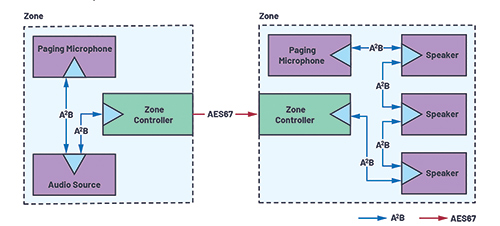
Expanded use cases
Originally a limited release product line offered for automotive applications only, A2B technology was fully released to the broad market in 2019, which opened it up to an abundance of applications.
The use cases in which the A2B bus has proven successful in the automotive industry are closely correlated with many use cases in the transport industry, to which the A2B bus was not previously available. One segment of the transport industry, construction and agricultural equipment, is undergoing rapid technological development. These machines are the working environment for their operators – meaning features like hands-free telephony, the integration of multiple microphones to facilitate beamforming, emergency call systems, and noise cancellation transform the machine into a safer, more comfortable, and connected working environment.
The Fritzmeier cab systems for off-highway industry and utility vehicles, with Antretter & Huber’s SMARTCOM system, leverage the scalable nature of A2B technology. Featuring microphones, active speakers, and an FM/DAB smart radio module, the SMARTCOM system is designed to simplify the integration of third-party modules. Key features of the A2B bus leveraged by the SMARTCOM system include the scope to integrate up to 10 slave nodes connected to a master node and the support for bidirectional audio traffic.
Vehicles that support carrying people (for example, buses, airplanes, and trains) constitute another important segment of the transport industry that can now leverage the capabilities of A2B technology. The connection of distributed audio components in these vehicles provides obvious use cases for A2B devices, such as the efficient connection of distributed speakers using cost-effective and lightweight UTP cables.
However, many more nuanced use cases exist. An A2B device’s support for up to 32 channels of downstream audio (from master node toward slave nodes) and upstream audio (slave nodes toward the master node) on the network facilitate the distribution of multiple channels of different audio content within a single system. This feature could be utilised in a tour coach to distribute music in a variety of genres, or tour guidance in a variety of languages.
The ability of the A2B bus to transmit non-critical general-purpose input/output (GPIO) data over distance can now be leveraged in several use cases within the transportation industry. For example, the stop buttons employed in buses and coaches could leverage this A2B capability due to the minimum processing overhead associated with it – once the A2B link is configured by the master node during initialisation, the GPIOs operate without any further host intervention.
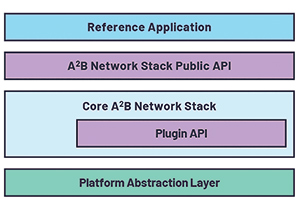
Outside the transport industry many standards, such as AES67, leverage technologies like Ethernet and Internet Protocol (IP) to transmit audio over a range of distances, from home or small studio installations to stadiums or shopping centre installations. A2B technology is not a direct competitor to many Ethernet-based technologies transmitting audio over long distances. Instead, A2B technology can be considered a complementary technology, perfectly suited to deliver edge connectivity between the backbone network and peripheral devices (for example, microphones, speakers, etc.).
In the context of a stadium installation, for example, an Ethernet technology such as AES67 is extremely effective in the distribution of audio throughout concourse areas or between local zones such as suites or restaurants. Within local zones, however, A2B technology offers several distinct benefits in bridging the Ethernet technology to the network edge.
Bridging Ethernet to the network edge
The A2B transceiver features an integrated network controller and PHY. The UTP connectors facilitated by A2B devices are cost-effective and easy to assemble, and the UTP cables accommodated by A2B devices are cost-effective, flexible, and lightweight. A2B technology is also highly optimised from a node processing perspective, with the scope to implement a slave node without the need for a microcontroller.
The A2B bus was designed from its outset to have minimal processing requirements throughout the entire network. During system initialisation, the transceiver on the master A2B node must configure the A2B network – a responsibility that resides with the host controller (which can be any IC/SoC with an I2C interface).
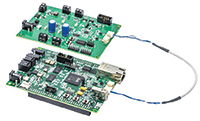
A reference software stack for network configuration is available from Analog Devices in either embedded C or Linux formats. Once the network has been configured, the only further software overhead is a function of the status-checking strategy selected for the application. This approach results in A2B technology comparing favourably to other technologies that require the execution of a complicated stack in every node connected to the network.
A2B technology’s minimal node processing requirement, in conjunction with its ability to provide power over the cable, makes the network eminently suitable for applications that require highly simplified slave node designs. Several applications within the recording studio environment can potentially leverage the support for simple node designs with bus power, such as talkback microphones or pickups.
Combining bus-powered nodes with locally-powered nodes, a system designer can create a complex studio design that leverages the 24-bit, 96 kHz digital audio path provided by A2B technology. The cable length supported by the A2B bus is another feature that can be leveraged in the studio or small stage environment. This flexibility could be leveraged in the small stage environment to connect elements such as the mixing desk, monitors, microphones, equaliser, or amplifiers.
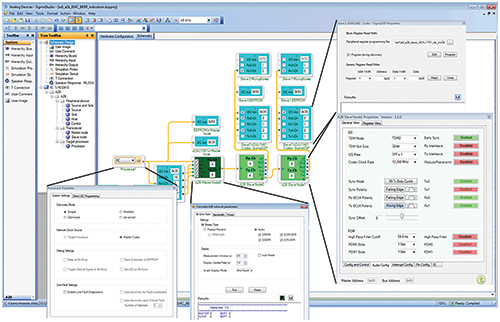
The cable length supported by the A2B bus can also be leveraged in the teleconferencing systems that are central to today’s meeting rooms. Teleconferencing systems require the connection of a variety of elements such as microphones, speakers, and mute buttons. Teleconferencing systems can also leverage the ultra-low, deterministic latency offered by A2B technology when implementing beamformed microphone solutions. The number of microphones involved, the processing power available, and the latency in the system influence the effectiveness of the beamforming implementation.
A2B technology offers synchronous data exchange with a guaranteed maximum latency of less than 50 µs. The GPIO support of A2B buses can also be leveraged in a teleconference system to communicate any auxiliary signals such as mute control buttons or in-call or muted status indicators.
The broader ecosystem
With a proven track record of EMI/EMC compatibility in the automotive environment, A2B technology offers an attractive proposition for applications that require the robust transmission of audio and non-critical data in the presence of a challenging EMC environment. Having achieved compliance to stringent automotive EMC standards including emissions, immunity, and ESD, the A2B bus is ideally suited to applications in avionics and aerospace. Compliant system designs can be achieved by maintaining consistency with fundamental design guidelines and following reference designs.
Such reference designs are an important element of the ecosystem necessary for a technology to simplify and accelerate the design-in process for customers. A2B technology is supported with hardware reference designs from Analog Devices and a number of third-party partners. Other traditional ecosystem elements include the availability of samples, documentation, and evaluation kits. In addition to these, the A2B ecosystem also includes three other important elements: software, design tools, and third-party design partners.

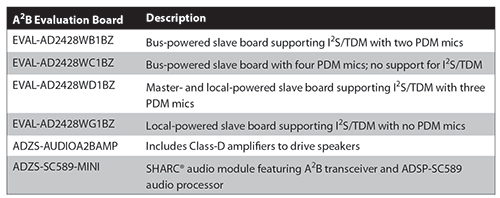
In addition to the reference software stack architecture mentioned earlier, A2B technology is also supported by Analog Devices’ industry-recognised development tool, SigmaStudio. SigmaStudio is a design tool used to support all aspects of the A2B design-in process – network design via drag-and-drop of A2B nodes and auxiliary devices, node configuration, bit-error rate analysis, bandwidth calculation, and power calculation. SigmaStudio takes the configuration data and generates generic .c and .h files for integration into the software stack.
Test equipment vendors including Mentor, Total Phase, and others are also part of the A2B bus ecosystem, offering products such as A2B analysers and monitors. An A2B analyser can emulate either a master node or slave node in an A2B network. This can assist when designing and prototyping an A2B network. An A2B monitor functions as a passive node on an A2B network and monitors all A2B audio and data passing through the node whilst supporting the input and output of audio. These tools assist in reducing time to market and design-in complexity for customers. They also accelerate the debug and investigation of issues during both the pre- and post-release stages of a project.
A2B technology has several third-party design service partners with proven track records in bringing A2B designs to the market. These partners offer a range of services from hardware modules to bespoke hardware and software design support.
Factors such as the ecosystem, EMI/EMC robustness, cable length support, and minimal processing overhead complement the audio and data transmission capabilities for which the A2B bus is best known. These factors and capabilities make A2B a very attractive proposition for applications across a wide variety of industries – transport, professional AV, or music production and performance.
Five generics of A2B transceivers have been released for broad market applications: two master devices and three slave devices. The five generics offered include superset and subset parts and an optimised endpoint slave device. An overview of the five generics supported is provided in Table 1.
The A2B bus is supported through a range of product evaluation boards from Analog Devices that cover the various generics of A2B devices. These boards are complemented by other A2B boards offered by the third-party design services.
| Tel: | +27 11 923 9600 |
| Fax: | +27 11 923 9884 |
| Email: | [email protected] |
| www: | www.altronarrow.com |
| Articles: | More information and articles about Altron Arrow |
© Technews Publishing (Pty) Ltd | All Rights Reserved